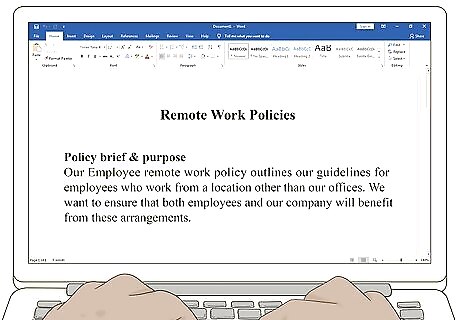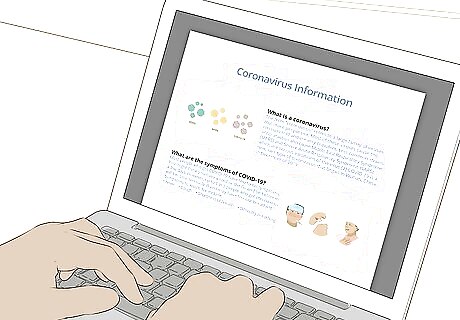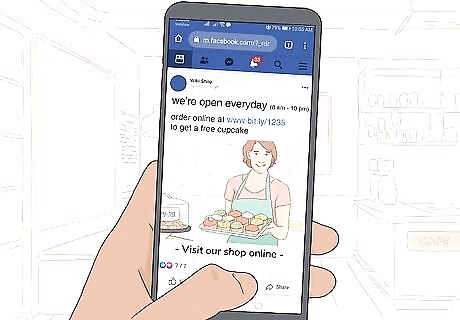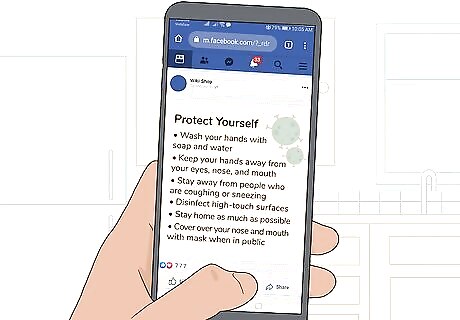
views
Setting up Remote Work

Put a small team in charge of managing remote workers. Your remote workers need to know whom to talk to if they have problems specifically related to remote work, such as accessing a document or logging on to your system. Assign specific people to deal with these issues. Having only 1 or 2 people in charge of this might be best if you have a small business with fewer than 100 employees. The people on this team should be relatively tech-savvy and able to troubleshoot connectivity problems and other tech issues with remote workers. If you have an IT person on staff, it's a good idea to put them on this team. Putting specific people in charge of these issues also ensures that problems are always resolved in the same way rather than having different employees come up with different strategies that may not necessarily fit together.

Draft clear remote work policies. Your employees need to understand what's expected of them while they're working from home. Let them know when their work will be reviewed and how they can communicate with their supervisors. Recognize that some employees may need to work different hours during the outbreak than they normally did. Decide what hours are appropriate and what times, if any, you specifically need your employees to be available. For example, you might have all employees available for a staff meeting each morning. After that, they are free to work when they can as long as they work at least 7 hours a day. You might also ask each employee to provide you with a rough schedule they intend to follow, so that management will know when to get in touch with them during the day.

Designate a virtual water cooler where your employees can interact. Having a connected and thriving workplace means allowing coworkers to socialize and talk about their common interests. Starting a chat base where employees can talk to each other, not only about work stuff, but about personal stuff too, will ensure that your employees feel less isolated while working from home. Several tech companies, including Google and Microsoft, are allowing free access to their chat apps, so you can set up private chats for your employees. Chat and instant messaging services, such as Slack and Microsoft Teams, allow individual employees and departments to communicate quickly and easily. You can also send company-wide alerts to make sure everyone is on the same page at all times.

Provide your employees with training and support to effectively work from home. Many of your employees may have never worked from home before. If possible, have a training day before they go remote, so you can introduce the systems they'll be using to work remotely. If your employees will be working on their personal computers, you might have them bring those computers into work, so you can help them load the software they'll need and teach them how to log on to the work programs. Give each employee a point-person to go to with any concerns or non-tech-related issues that come up. That person might be their direct-report supervisor or someone else in management. Encourage your employees to use productivity and time trackers to help them stay on task during working hours, as well as ensure they get the breaks they need. Apps such as Toggl and Todoist are popular.Tip: Poll your employees to find out who has experience working from home. Those who are familiar with remote work can help the others adjust.

Create a coronavirus information hub for employees. The coronavirus outbreak is a rapidly developing situation and your employees may not know where to turn to get reliable information or understand how that information might impact their jobs and your industry. Assign a team member to carefully curate information from reliable sources, such as the WHO and the CDC, as well as federal, state, and local government resources. With all information that you share, indicate clearly whether that information affects your business. If it does, specifically list the adjustments your business is making.

Check in on your employees regularly. The pandemic is a scary time and people's lives are undergoing many changes. Call your employees and make sure they're doing okay and don't need additional support. Listen to their concerns and do what you can to help them with any issues they may have. Empathize with employees who need to care for sick family members or who are dealing with kids at home. You might consider giving them some time off or flex-time to deal with their responsibilities. Provide mental health resources to all of your employees to help them maintain their stability. Make sure your employees are taking time for self-care and not succumbing to stress.

Have online meetings at least once a week. Online meetings allow your employees to see and connect with each other, so they feel less alone and less isolated. While business talk may dominate your meetings, allow time for employees to decompress and talk about the challenges they're facing. Google Hangouts and Zoom are popular choices for video conferencing with remote workers.Tip: If your meetings involve a mix of people in one room at the office and others who are remote, let the remote people speak first. It will give them more of a sense that they are in the room with you and are active members of the team.
Marketing Your Business

Brainstorm ways to adapt delivery of your products or services. The outbreak deeply affects many small businesses, but particularly those that sell non-essential products and services, whether to consumers or to other businesses. Digital technology provides numerous ways for you to continue to get your products or services out to customers. For example, if you've had to close a storefront, online sales might be an option. If you don't have an online storefront set up, you could also take orders over the phone. If you sell services, there may be ways for you either to offer those services virtually or to arrange to continue those services in a way that honors social distancing. For example, if you have a dog grooming business, you could meet clients at their car and take their pets inside for grooming, then bring them back out when you're done. Advising, consulting, or agent services can be conducted virtually using video-conferencing and cloud-based document-sharing services, such as Google Drive or Dropbox.

Look for ways your product or service could have additional uses. People's needs are changing with the pandemic, particularly as many people are spending more time at home than they normally would. If your product or service has particular uses that could benefit people at this time, you can highlight those uses to increase sales. For example, suppose you have a clothing boutique. If you sell scarves, you could start retro-fitting them into designer masks for customers to where when they have to be out in public. As another example, if you own a bakery and your local grocery stores are consistently out of bread, you might bake loaves of bread that people can buy. Arrange for either delivery or curbside pick-up.

Promote gift cards to help your business stay afloat. Gift cards give your business a quick infusion of cash that can help you stay afloat, even if business has decreased due to the outbreak. Additionally, gift cards guarantee you'll have customers after the crisis is over. If you have an email list, use that to encourage your regular customers to buy gift cards for themselves and their friends and family. You can also offer gift cards through your social media accounts.Tip: Consider running a sale for customers who buy gift cards during the outbreak. For example, you could add a coupon for 10% off their purchase made with the gift card.

Adapt your business to offer new products or services. The coronavirus outbreak presents new challenges and people have needs that didn't exist before the outbreak. If you can find some way to fulfill those needs, you may be able to attract new customers to your business during the outbreak. For example, if you own a distillery, you might start making hand sanitizer instead of spirits.

Try hosting webinars if you have a B2B business. If you offer products and services to other businesses, webinars can help you communicate the benefits of your product or service without anyone having to leave their home. Additionally, instead of talking to only one potential client, you can present your business to several at a time. Webinars also give potential clients a chance to ask questions and also participate in a discussion based on questions other potential clients might ask. These discussions can give you ideas about other products or services to offer. If your webinars are successful, they might prove valuable not only during the outbreak but also after the situation has calmed down.
Communicating with Customers

Make it clear to your customers that you're still open and going strong. Many customers might think of your business and wonder whether you're open. You can end that doubt by posting regularly on social media to let your customers know that you're ready to serve them and your community. Along with letting your customers know that you're open, detail the steps you're taking to keep both your customers and your employees safe and healthy. For example, you might emphasize that your store is closed, but customers can still pick up orders. Many businesses have shorter hours during the pandemic. Communicate your hours clearly on every post, along with a phone number where customers can reach you.

Notify your customers proactively of policy changes. The response to the outbreak means that the situation on the ground can change rapidly. Use social media or email lists to let your customers know of any changes before they actually take place, so your customers can adjust accordingly. Keep in mind that many people only go out once a day if they have to, so any change to store hours or delivery schedules definitely needs to be communicated in advance. For example, you might send out an email to your customer list on Friday letting them know that effective Monday, you will only be open from 10 a.m. until 2 p.m. Monday through Friday. You prefer not to be seen as dragging your feet when it comes to closing your doors or making changes to your operations. Your customers may interpret this as you putting your profits ahead of the health and safety of your employees and your customers. Instead, act before the government tells you to do so.Tip: While you obviously have to comply with government mandates, you will earn goodwill with present and potential customers if you can show that you're going above and beyond to protect the health and safety of your community.

Offer incentives for customers who stick with you. Since many of your customers have to stay at home, they may look to online or other remote solutions to solve the problems they previously solved with your product or service. After the public health crisis has passed, they may stick with that new solution rather than returning to you. For example, you might offer price-matching or free delivery to customers during the outbreak. To get customers to return, offer a coupon or discount that is only valid for several months, when the worst of the crisis will likely be over. That can help ensure your customers return.

Engage customers with online events. Parties and events can be ways to engage regular customers as well as pick up new ones. However, during the outbreak, you likely can't hold live events. Use virtual events instead to entertain customers as well as spark a sense of community. For example, if your business is celebrating a 5-year anniversary, you might host an online party and stream a local band as live entertainment. You could send out an email to your regular customers as well as publicizing the event on social media. If you own a bar or pub, you might talk to a bar trivia company about hosting a virtual trivia night. You could offer a pitcher of beer or gift card as a prize for the winning team — this gets customers back in your bar after the outbreak.Tip: Services such as YouTube and Facebook Live are free and allow you to live-stream your virtual event to your customers.

Provide free or discounted shipping for online orders. Having to pay for shipping is often one of the main reasons customers don't like to shop online at any time. But especially during the outbreak, many people have tight budgets and don't want to spend their money on shipping costs. You might offer free shipping or delivery for orders over a certain amount — say, $35 or $50. Look at your average sale, then add $5 or $10 to that. For example, if your average sale is $45, you might offer free shipping for purchases over $50. For small local businesses, another option is to offer free delivery to local customers, then charge for shipping to non-local customers.

Use social media to empathize with customers. The outbreak is an unpredictable time and many of your customers are just looking for some reassurance and some stability in their lives. Reassuring them that your business is there to support them and the community will go a long way toward establishing goodwill and customer loyalty for your brand and your business. Share tips to help your customers during the outbreak as well as entertaining, inspiring, and lighthearted stories or memes that your customers will identify with. Let the coronavirus outbreak be a time for you to humanize your business and demonstrate that you are a part of the community. You might also highlight stories from your employees who are dealing with the outbreak.
Maintaining Smooth Operations

Identify clearly the challenges your business might face. Sit down with your management team to determine the sorts of problems your business might encounter. Start with challenges after a couple of weeks, then expand from there. Consider that you might be closed to the public for a couple of months. For example, if you own a restaurant, your challenges might include not being able to have the dining room open and not being able to get adequate food supplies. Once you've listed your challenges, work with your management staff to brainstorm ways to surmount the challenges you've identified. For example, as a restaurant, you might use your front-of-the-house staff to deliver food to people or set up curbside pick-up options.Tip: If you have a small business with only 1 or 2 people at the management level, you might consider bringing in some of your senior employees who've been with you for a while to help identify challenges and brainstorm solutions.

Create a single team to manage operations through the crisis. During any crisis, communication is of the utmost importance to ensure that everyone in your business is on the same page. If you have a relatively small business, your team may simply consist of people who already managed operations. For larger businesses, keep the team to 5 to 7 people. Arrange for the team to meet regularly and keep their operations transparent for the rest of the organization. Using Google Docs or a similar program will help the team share information easily.

Update business tracking and forecasting on a daily or weekly basis. You might have previously updated your business reports on a monthly or even quarterly basis. However, because the coronavirus outbreak is a rapidly developing situation, you need to keep closer track of your business situation, so you can pivot and adapt as necessary before your situation becomes too bleak. Be transparent with your reports and share them with management and the members of the team you've put in charge of your outbreak response.

Use alternative sources to help stabilize your supply chains. Because of the outbreak, supplies and product may be slower to arrive or may not arrive at all. If you're dependent on manufacturers, you may be hampered by plant closures. Some vendors may also close temporarily. Identify sources that are operating through the outbreak so that you always have back-ups. Even if your supply chain isn't affected, assume that it might be in the coming weeks. If you find alternative suppliers now, you won't have to look for them after you've already run out of something. Spreading the demand across multiple suppliers rather than using just one also helps stabilize the supply chain, even though it might be slightly less efficient for you.

Focus on empathy over new business opportunities. Some businesses may happen upon new growth opportunities as a result of the pandemic. However, that shouldn't be your main focus as a business during the outbreak. Rather than investigating options for capitalizing on the situation, investigate options for empathizing with the plight of your community and your customers. Take actions that would best serve your community and your customers' interests during this time, rather than actions that would improve your bottom line. Keep in mind that the best thing for you to do might not necessarily be the best business move. For example, suppose you run a health and fitness center and have had to close. If you continued to take monthly membership fees from your customers, you would certainly be able to weather the storm. However, that would breed resentment and could result in customers canceling their memberships. Instead, you could suspend payments for 2 or 3 months.

Stay flexible, so you can adapt to a rapidly changing situation. Take advantage of the technology that's available to you to find ways to help your business adapt to the crisis. Keep avenues open that you might not normally consider so that you have options. If you get bogged down in old methods of running your business and refuse to adapt, your business might have a hard time surviving the outbreak. Instead, be open to anything that could help your business stay afloat during this uncertain time.



















Comments
0 comment